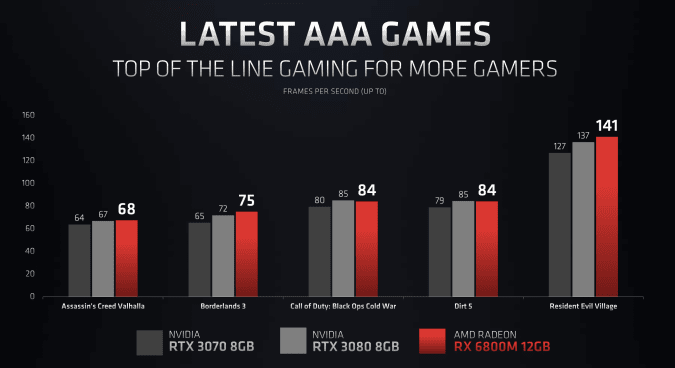
[ad_1]
AMD is finally bringing its RDNA 2 technology to notebooks. During its Computex keynote today, the company announced the Radeon RX 6000M series of mobile GPUs. They’ll bring over most of the upgrades we saw in the RX 6000 desktop GPUs to laptops: far better power efficiency, faster performance and ray tracing support. The new lineup will be spearheaded by the Radeon RX 6800M, which aims for high-framerate (120fps) 1,440p gaming. Just like on the desktop side, it’ll be directly targeting NVIDIA’s RTX 3080.
Not surprisingly, AMD is also launching the RX 6700M and 6600M models, which will focus on 100fps 1,440p gaming and 1080p performance, respectively. AMD claims the new GPUs offer up to 50 percent faster speeds, as well as up to 43 percent lower power usage, compared to its previous RDNA GPUS. Those cards — the Radeon 5000M lineup — didn’t make a huge splash in games, but were notable for debuting in Apple’s late 2019 MacBook Pros. (It was one of the major reasons the MacBook Pro 16-inch was such a powerhouse.)
Under the hood, the RX 6800M features 40 compute units and ray accelerators, along with 12GB of GDDR6 RAM. It shares a 2.3GHz game clock speed with the 6700M, but that card has 36 compute units and 10GB of RAM. The entry-level 6600M, meanwhile, sports 28 compute units and 8GB of RAM. Memory interfaces also scale from 192-bit on the high end card to 128-bit on the low end. From the specs alone, AMD’s new hardware seems like a major leap forward. The previous Radeon 5000M cards topped out with 36 compute units and 8GB of RAM. (It’s no wonder they never made it into many gaming laptops.)

AMD
AMD claims the Radeon RX 6800M outperforms NVIDIA’s RTX 3080 in major AAA titles like Assassin’s Creed Valhalla and Resident Evil Village. Normally I’d take that with a huge grain of salt, but I’ve also been testing a 6800M equipped ASUS ROG Strix G15, and I can confirm it outperforms the 3080 in 3DMark’s TimeSpy Extreme benchmark. (We’ll have a full review of that machine coming soon.) Just like its desktop siblings, though, the 6800M lags behind NVIDIA’s hardware in the Port Royal raytracing benchmark. But hey, at least ray tracing is an option this time.
If you were ever planning to game while on battery, AMD says the the 6800M is around 40 percent faster than the 3080 while playing Resident Evil Village. Obviously, unplugged gaming is something most player try to avoid whenever possible, but it’s nice to know AMD is at least thinking about it. It’s not inconceivable that you’d want to game a bit while on a long drive, or a flight, without a power plug nearby.
Now that AMD has blistering fast Ryzen 5000 mobile CPUs and powerful new GPUs, it’s also trying to entice consumers (and PC makers) with its new AMD Advantage Framework. Similar to Intel’s Evo branding, it’s a way for shoppers to know they’re getting a solid gaming experience. Specifically, AMD Advantage systems will sport the latest Ryzen CPUs and Radeon GPUs, fast refresh rate displays above 144Hz, FreeSync premium screens for tearing-free gaming, and speedy NVMe drives. Really, those are the sorts of things you’d look for in any modern gaming PC, but AMD’s badge just makes it easy to know the minimum you can expect from a new system.
Those AMD-equipped systems should also perform slightly faster than laptops with Ryzen CPUs and NVIDIA GPUs, thanks to the company’s Smartshift and Smart Access technology. Those features can intelligently balance power between AMD’s CPUs and GPUs, and also give the CPUs direct access to the gobs of RAM in Radeon GPUs. The company claims they can lead to an 11 percent speed boost in Borderlands 3 and a 10 percent improvement in Wolfenstein Young Blood.
Additionally, AMD announced FidelityFX Super Resolution, the latest in its suite of open source visual tweaks. Similar to NVIDIA’s DLSS technology, it’s a way to speed up high resolution gaming by scaling up lower resolution textures. In a demo of Godfall, running in 4K with ray tracing, FSR was able to speed up performance by 59 percent. AMD is also offering four different FSR modes, allow you to optimize for speed or visual fidelity.
Given just how essential DLSS has been for ray traced games like Control, it’s about time AMD has something competitive. Even better, the company says FSR will also be compatible with NVIDIA’s hardware. (It’s open source, after all.)
You can find systems like the ASUS ROG Strix G15, HP Omen 16 and others in June. FidelityFX Super Resolution, meanwhile, will launch on June 22nd.
All products recommended by Engadget are selected by our editorial team, independent of our parent company. Some of our stories include affiliate links. If you buy something through one of these links, we may earn an affiliate commission.
[ad_2]
Source link






